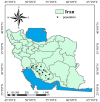Essential Oil Chemical Variability in Oliveria decumbens (Apiaceae) from Different Regions of Iran and Its Relationship with Environmental Factors
- PMID: 32471254
- PMCID: PMC7356547
- DOI: 10.3390/plants9060680
Essential Oil Chemical Variability in Oliveria decumbens (Apiaceae) from Different Regions of Iran and Its Relationship with Environmental Factors
Abstract
Oliveria decumbens Vent. (Apiaceae) is an annual herb resistant to harsh environmental conditions, which has got numerous pharmacological, food and feed, and cosmetic applications. In the present study, the variation in the essential oil (EO) content and composition of twelve O. decumbens populations growing wild in several habitats of Iran was studied. The EO contents varied from 2.71% (Darab) to 8.52% (Behbahan) on a dry matter basis, where the latter population revealed to be the highest source of essential oil reported so far in this species. Gas chromatography (GC-FID) and gas chromatography-mass spectrometry (GC-MS) analysis revealed that carvacrol (18.8-51.8%), thymol (20.3-38.7%), γ-terpinene (0.9-28.8%), p-cymene (1.6-21.3%) and myristicin (0.8-9.9%) were the major volatile compounds in all the investigated populations. The EO content had a strong and significant positive correlation with temperature (r = 0.62) and sand content (r = 0.73), but a strong and significant negative correlation with altitude (r = -0.61). On the other hand, the rising altitude led to an increase in thymol content. Cluster and principal component analyses placed the samples from different regions into two main groups based on the main EO components, including thymol/carvacrol type and γ-terpinene/thymol/carvacrol/p-cymene type. This study provides valuable information for identifying chemotypes in O. decumbens as well as insight into planning a domestication and cultivation program.
Keywords: Oliveria decumbens; carvacrol; environmental factors; essential oil (EO); thymol.
Conflict of interest statement
The authors declare no conflicts of interest.
Figures





Similar articles
-
The Variability of Thymol and Carvacrol Contents Reveals the Level of Antibacterial Activity of the Essential Oils from Different Accessions of Oliveria decumbens.Antibiotics (Basel). 2020 Jul 14;9(7):409. doi: 10.3390/antibiotics9070409. Antibiotics (Basel). 2020. PMID: 32674440 Free PMC article.
-
Phytochemistry of Oliveria decumbens Vent. (Apiaceae) and its therapeutic potential: A systematic review.Fitoterapia. 2023 Oct;170:105647. doi: 10.1016/j.fitote.2023.105647. Epub 2023 Aug 9. Fitoterapia. 2023. PMID: 37562490
-
Oliveria decumbens essential oil: Chemical compositions and antimicrobial activity against the growth of some clinical and standard strains causing infection.Microb Pathog. 2018 Jan;114:449-452. doi: 10.1016/j.micpath.2017.12.033. Epub 2017 Dec 11. Microb Pathog. 2018. PMID: 29241765
-
Thymol screening, phenolic contents, antioxidant and antibacterial activities of Iranian populations of Trachyspermum ammi (L.) Sprague (Apiaceae).Sci Rep. 2022 Sep 19;12(1):15645. doi: 10.1038/s41598-022-19594-7. Sci Rep. 2022. PMID: 36123425 Free PMC article.
-
Oliveria decumbens, a Long-Neglected Plant with Promising Phytochemical and Biological Properties.Chem Biodivers. 2024 Jul;21(7):e202400810. doi: 10.1002/cbdv.202400810. Epub 2024 Jun 24. Chem Biodivers. 2024. PMID: 38743456 Review.
Cited by
-
The Variability of Thymol and Carvacrol Contents Reveals the Level of Antibacterial Activity of the Essential Oils from Different Accessions of Oliveria decumbens.Antibiotics (Basel). 2020 Jul 14;9(7):409. doi: 10.3390/antibiotics9070409. Antibiotics (Basel). 2020. PMID: 32674440 Free PMC article.
-
The Essential Oil from Oliveria decumbens Vent. (Apiaceae) as Inhibitor of Breast Cancer Cell (MCF-7) Growth.Pharmaceuticals (Basel). 2022 Dec 30;16(1):59. doi: 10.3390/ph16010059. Pharmaceuticals (Basel). 2022. PMID: 36678556 Free PMC article.
-
Variations in Essential Oils from the Leaves of Cinnamomum bodinieri in China.Molecules. 2023 Apr 23;28(9):3659. doi: 10.3390/molecules28093659. Molecules. 2023. PMID: 37175069 Free PMC article.
-
Enhancing the shelf life of rainbow trout fillets using edible sodium caseinate coating with Oliveria decumbens essential oil nanoemulsion, vitamin E and sodium dodecyl sulfate.Iran J Vet Res. 2025;25(4):333-343. doi: 10.22099/ijvr.2024.48884.7185. Iran J Vet Res. 2025. PMID: 40386096 Free PMC article.
References
-
- Mozaffarian V. A Dictionary of Iranian Plant Names. Farhang Moaser; Tehran, Iran: 1996.
-
- Sereshti H., Izadmanesh Y., Samadi S. Optimized ultrasonic assisted extraction dispersive liquid–liquid microextraction coupled with gas chromatography for determination of essential oil of Oliveria decumbens Vent. J. Chromatogr. A. 2011;1218:4593–4598. doi: 10.1016/j.chroma.2011.05.037. - DOI - PubMed
-
- Esmaeili H., Karami A., Maggi F. Essential oil composition, total phenolic and flavonoids contents, and antioxidant activity of Oliveria decumbens Vent. (Apiaceae) at different phenological stages. J. Clean. Prod. 2018;198:91–95.
-
- Saidi M. Antioxidant activities and chemical composition of essential oils from Satureja khuzestanica, Oliveria decumbens and Thymus daenensis. J. Essen. Oil. Bear Plants. 2014;17:513–521. doi: 10.1080/0972060X.2014.901607. - DOI
LinkOut - more resources
Full Text Sources
Miscellaneous

